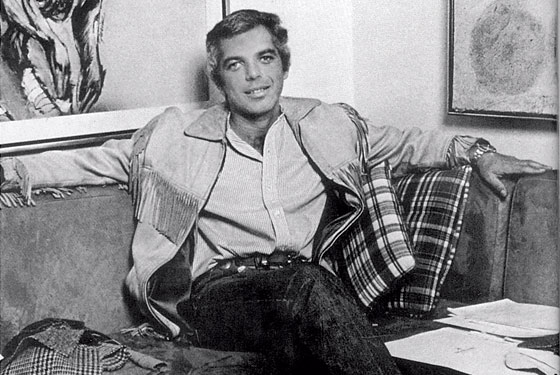In 1973, in an age of counter-culture experimentation when women tried on pants suits and men sported Nehru jackets, von Furstenberg introduced the wrap dress, an unapologetically feminine design. Her genius was to rebel against trend. “Women were ready for clothes that let them be both sexy and successful, powerful and practical and the wrap dress satisfied those needs,” she says.
Von Furstenberg—whose wrap dress is still popular—celebrates her Jewish roots, although Yom Kippur is the only Jewish holy day on her calendar. “I believe in the message of the holiday. For me it is a time of reflection and contemplation. [It’s] a clean start for the new year.”
While von Furstenberg’s appeal was to women of every age and income, another Jewish immigrant designer was making a name for herself in luxury, designing whimsical jeweled handbags for first ladies and Hollywood stars. Born and raised in Budapest, Judith Leiber was spared the concentration camps thanks to a forged diplomatic passport. Forced to abandon her dream of studying in London, she instead became an apprentice to a handbag craftsman. “If the Nazis hadn’t occupied Budapest, I would have become a chemist,” Leiber recalls. With her father an art collector and her grandmother a hat designer, Leiber muses, “perhaps I inherited a sense of design.”
Fashion was in the blood of many post-war designers. Donna Karan, creator of the DKNY line that is a tribute to urban, sophisticated style, grew up in the industry. Her mother was a model, her father a tailor and her stepfather a hat-maker. At 14, working in a clothes shop, she felt confident enough to advise customers on which outfits would most flatter their figures. She trained at Parsons School of Design before signing up with Anne Klein. In 1974, just after Karan gave birth to her daughter Gabrielle, Klein, only 50, died of breast cancer. Executives asked the 26-year-old Karan to complete the collection and later named her chief designer for the Anne Klein brand. She kicked off her own DKNY line nine years later.
Like Karan, Kenneth Cole has family roots in the profession—his father Charlie owned the El Greco shoe manufacturing company. In 1982, the younger Cole set out to preview his own line of shoes at Market Week at New York’s Hilton Hotel. Without funds to pay for a hotel room let alone a showroom, Cole rented a trailer. But the city would only grant parking permits to trailers used in movies, so he changed his company’s name to Kenneth Cole Productions, writing in his application that its purpose was to shoot a full-length film, The Birth of a Shoe Company. The story goes that he sold 40,000 pairs of shoes in three days, and did make a movie. Ever since, he has been known for elegant footwear.
Isaac Mizrahi is also a child of the business. The only son of Zeke and Sarah Mizrahi, he grew up in a tight-knit Syrian Jewish community in New Jersey. His father worked in the garment industry, first as a pattern cutter on Wooster Street and later as a manufacturer of children’s clothes. His mother took her son to the ballet, and on shopping expeditions to the major department stores, teaching him to hunt for quality, showing him the magic of designers like Chanel and Cristobal Balenciaga, a Spaniard in Paris with a reputation for exacting standards.
Openly gay, Mizrahi has said he feels Jewish in his soul but is conflicted by the orthodox belief that homosexuality is wrong. (Another Jewish-born designer, Michael Kors—regarded by some as “a groovy alternative to Oscar de la Renta”— is so conflicted he is said to no longer identify himself as a Jew.) Once, when Mizrahi was asked about what defines couture, he described in loving detail the way designer clothes are made—the special press of the jacket, the turned head of the sleeve, the way the shoulder pads are inserted. “God,” he said, “is in the tailoring.”
Mizrahi was one of the first designers to take his fabulous seams down market, partnering first with Target and now with Liz Claiborne to deliver fresh, trendy clothes at a modest price. He was also one of the first to mass manufacture offshore, taking advantage of cheap third world labor.
Both trends have deeply impacted the fashion industry: American design may still be king but American factories have moved to Asia and beyond. “More clothing comes into the Port of Los Angeles from Asia than any other point on the globe,” says The Wall Street Journal’s Binkley. “Massive quantities are being made in factories that run 24 hours a day. We’ve added seasons, so stores have new collections every week.” Increased production is not all positive, she adds. “Some would argue that this benefits the consumer, who gets the clothes quickly. But we are filling landfills.”


full informative and nice article Today, Lauren is ubiquitous in fashion, head of a powerful global empire that designs all of its products—from sportswear to fragrances to home furnishings and even paint—with an aura of casual American comfort and upper-crust British class
thanks ……….
I enjoyed learning about Ralph Lipshitz Lauren was raised by his Kewish family and became interested in fashion.